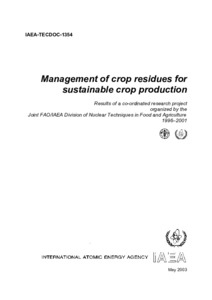| dc.contributor.author | Diels, J. |
| dc.contributor.author | Lyasse, O. |
| dc.contributor.author | Sanginga, N. |
| dc.contributor.author | Vanlauwe, Bernard |
| dc.contributor.author | Aihou, K. |
| dc.contributor.author | Iwuafor, E.N.O. |
| dc.contributor.author | Merckx, R. |
| dc.contributor.author | Deckers, J. |
| dc.date.accessioned | 2019-12-04T11:30:55Z |
| dc.date.available | 2019-12-04T11:30:55Z |
| dc.date.issued | 2002 |
| dc.identifier.citation | Diels, J., Lyasse, O., Sanginga, N., Vanlauwe, B., Aihou, K., Iwuafor, E.N.O., ... & Deckers, J. (2003). Options for soil organic Carbon maintenance under intensive cropping in the West-African Savanna. In Management of crop residues for sustainable crop production. Vienna, Austria, International Atomic Energy Agency. (p. 99-110). |
| dc.identifier.isbn | 92-0-104203-5 |
| dc.identifier.issn | 1011-4289 |
| dc.identifier.uri | https://hdl.handle.net/20.500.12478/5417 |
| dc.description.abstract | Data from the derived savanna zone in southern Benin indicated that some intensive cropping systems (maize/Cajanus and maize/Mucuna relays; maize/cotton with Senna siamea hedgerows) returned about 12 Mg DM ha-1 year-1 of plant biomass to the soil. This compared favorably with the 8 Mg DM ha-1 year-1 reported for current maize/cotton and maize/cowpea systems. Based on calculations with the Rothamsted carbon model, this extra biomass translates into an increase in the topsoil carbon content of 0.33% C after 20 years. These calculations were found to be in line with available data from long-term experiments in West Africa. While the relation between residue-input rates and soil organic carbon (SOC) buildup is reasonably well known, little is known about how this translates directly into yield benefits. As a way to identify the potential of such benefits, we translated achievable SOC gains into increases in top-soil CEC, pH-buffer capacity, and available water (AW) in the soil profile in relative terms, i.e. relative to the AW without additional SOC buildup, and relative to the CEC and pH-buffer capacity contributed by the mineral soil constituents. This indicated that achievable increases in AW from higher SOC contents are insignificant. Furthermore, we found that increases in CEC and pH-buffer capacity through SOC buildup can be justified only in a limited number of soils where the mineral fraction in the topsoil provides very little buffering. Finally, we used a response-curve approach to single out the various benefits from organic matter inputs and to look at interactions with mineral fertilizers. We also indicated the scope for a more mechanistic interpretation, focusing on the effect of increased pH buffering as a way to minimize losses from NH3 volatilization with urea applications in poorly buffered soils. |
| dc.language.iso | en |
| dc.subject | Biomass |
| dc.subject | Mucuna Pruriens |
| dc.subject | Cowpeas |
| dc.subject | Cajanus Cajan |
| dc.subject | Weeds |
| dc.subject | Maize |
| dc.subject | Cotton |
| dc.subject | Fertilizers |
| dc.subject | Organic Matter |
| dc.title | Options for soil organic carbon maintenance under intensive cropping in the West African savanna |
| dc.type | Book Chapter |
| cg.contributor.affiliation | International Institute of Tropical Agriculture |
| cg.contributor.affiliation | Institut National des Recherches Agricoles du Bénin |
| cg.contributor.affiliation | Institute of Agricultural Research |
| cg.contributor.affiliation | Katholieke Universiteit, Leuven |
| cg.coverage.region | Africa |
| cg.coverage.region | West Africa |
| cg.coverage.country | Benin |
| cg.authorship.types | CGIAR and developing country institute |
| cg.iitasubject | Cowpea |
| cg.iitasubject | Grain Legumes |
| cg.accessibilitystatus | Open Access |
| local.dspaceid | 103774 |

